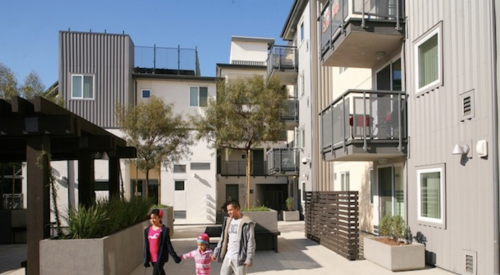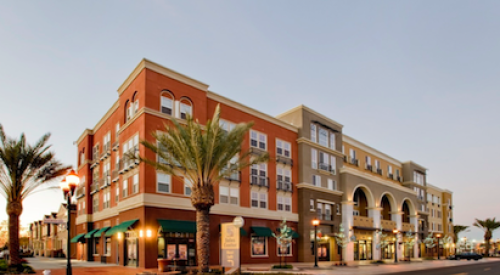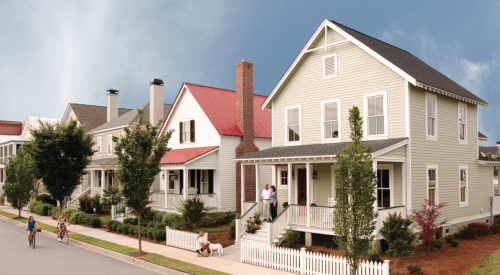|
Restored to the splendor that inspired them in the 1890s, brownstones on John R. in Detroit's Brush park neighborhood are fetching prices in the $400,000s without a problem, reports Crosswinds Development. Plans of three stories plus basement incorporate private courtyards, such amenities as a fireplace, granite counter tops and hardwood floors, plus two-car attached garage.
|
|||||||||
|
|
|||||||||
|
Just seven units in the artsy Seward neighborhood of Minneapolis, the 21st Street Lofts take a new twist on conventional building materials. Promoting economical construction ($105 per square foot) and the bohemian flair Lander Group and architect DJR were aiming for, metal siding and varied exterior hues accent the building geometry. Inside (below), pine slat walls add to the feeling of light, airy and hip loft housing.
Photos by Alex Steinberg |
Like the new teeth in a young child's smile, infill projects are springing up to span the gaps of passed-over suburban parcels, deserted industrial sites and the historic cores of America's cities. Opportunities are fueled by households and lifestyles that don't resemble Ozzie's and Harriet's; time starvation made worse by grinding commutes; pride in historic downtowns; a desperate need for first-time, service sector and senior housing; dwindling supplies of viable green fields; and the allure of a hip, live/work address with entertainment close at hand.
"Two decades ago, the infill market was practically nonexistent," says Tracey Appelbaum, a principal with MacFarlane Partners of New York, an investment management firm specializing in urban mixed-use projects. "Today, more developers are trying to feed a growing demand, and we are comfortable that we can deliver superior investment performance from urban properties."
Current infill practitioners create everything from small clusters of new homes in city neighborhoods to extensive new neighborhoods within a first- or second-ring suburb. In the search for golden opportunities, these developers look under every stone. They purchase surplus school property to create fresh housing stock (and generate per-pupil state funds for a suburban community). They revitalize a university town's retail/commercial hub. They work with city fathers to transform a defunct naval yard into a vital pocket of housing, hotel and restaurant space. They seek Amtrak land leases for profitable transit-oriented development, or TOD.
The Players
Today's infill developers are an amalgam of national development companies and socially conscious hometown builders; of imaginative deal makers; and methodical problem-solvers. They range from those with a finite, design-driven niche to those with a broader portfolio.
Some specialize in entitling land for public home builders, which need new opportunities and have no internal staff to make a local deal. Some see a mission. "It's the duty of a developer with the wherewithal and resources to revitalize the downtown of his or her community," says Bernie Glieberman, founder of Crosswinds Communities in Novi, Mich.
The premise is simple: Find and define the opportunity, control it, capitalize it and deliver what the market wants - profitably. Particulars are never simple, but the infill crowd is a resourceful lot, seeing obstacles as opportunities. Contaminated soil, high voltage wires, multiple owners, dicey infrastructure and apprehensive neighbors are all part of the deal, even welcomed by some, including Sarah Peck, founder of Progressive Housing Ventures in the Philadelphia area. Formerly involved in conventional home building and development, she enjoys the opportunity to wear the white hat.
"I look for well-located sites with significant problems," Peck says. "New, quality housing represents an improvement for the neighbors. I leave something better on the landscape."
To make the deal work, infill developers network, eager to maximize pooled expertise. Consortiums come in every configuration, from conventional joint ventures to local pals who pooled their talents once and discovered it works.
They also take chances. "This is not a commodity business, and it's not for the faint of heart," says Cathy Greenwold, executive vice president and director of development for TMG Partners, an acquisitions and development company. "We have no template."
What Will The Neighbors Say?
Infill presents one common issue, mentioned first and described at length by all who practice it: Each project is unique. In the same breath, developers cite one key factor that can determine a project's success: addressing the issues, needs and expectations of surrounding stakeholders. Key observations:
- Don't make assumptions. In the San Francisco Bay area, keeping development from happening is not the concern, according to David Cropper, a partner with TMG. "You are putting use back into the middle of things, and few resist that in a place where land is scarce and price is high. Phoenix infill is different because there is still available land. Our plan is always a blank sheet of paper until we hear from the community. We don't go in with our bright ideas ."
- Listen. "Identify the community's core values and incorporate them as the project's core values," says Jack Skelley, public relations director of Roddan Paolucci Roddan in Palos Verdes Estates, Calif. This converts objectors into allies for re-zoning, density increases, parking allotments and similar accommodations.
- Look at nuances. Neighbors may express concerns about specifics, but they also may just be afraid of what any change will bring, says David DiRienzo of Urban + West + Strategies. "Consider the people first; the real estate, second."
Recognize that people are apprehensive, not just about what may be developed but also about what the developer's attitude may be. "If you ramrod the project, you can get it done, but the next one will be harder," cautions Michael Lander of the Lander Group in Minneapolis. "We want the next project to be better."
- Stay proactive. Ivanhoe Huntley Homes of West Bloomfield, Mich., doesn't wait for the public comment phase. "We always meet with neighborhood groups before our first meetings with municipalities," says Gary Shapiro, marketing director. "If the neighborhood groups get wind of a project, they invariably receive misinformation. In a friendly, one-on-one environment like our offices or a restaurant, we can dispel rumors and show why what we propose is better."
The same approach pays dividends once a project is under way. At One Boulder Plaza in Boulder, Colo., the mixed-use project's size and scope translated into months of disruption for the Pearl Street Mall neighborhood. The downtown location limited staging flexibility for developer Vail Lizard LLC, making dust, noise and traffic issues inevitable.
Vail Lizard implemented organized communications to broadcast news of street closures and duration, alternate routes, and what the community could expect as construction progressed. Channels of communication included radio, newspaper and Internet.
"Boulder is a small enough town that people feel free to call the city council about any problem," says Vail Lizard partner Jerry Lee. "We learned fast that communication was critical."
- Explain the win/win, such as more affordable housing for young buyers, service sector families and seniors who want to stay in their community. "It's a big task to explain that density brings unit costs down, which brings more housing up to a greater mean population at an affordable price, but that is the goal," says Shapiro. "In the meantime, ask for more than you need. Remember, if you ask for 20 units, they will say 10."
- Work with the city. In San Bruno, Calif., city fathers jump-started the specific plan for a 20-acre naval base by commissioning the Environmental Impact Report, assembling a citizens advisory committee and defining priorities. TMG, Sares Regis Homes and financial partner CalPERS listened and responded.
- Work as an inclusive and dynamic team, with the consultants, developer, lender, city and planning officials. "You have to rely on the power of shared expertise to create a viable, approvable project," says Rick Aiken, principal of mixed-use development for WHA Inc., architects and planners in Irvine, Calif. "Infill developers cannot just hand over the assignment and let the consultant work on his own."
Learning Curves
With the right approach to stakeholders comes the silver lining, according to Lander and others. Neighbors who begin with strenuous objections can become the project's staunchest supporters, contributing mightily to approved proposals. That's especially important with infill because of the time and trouble these projects require. Some basics:
- Multiple property owners are the norm, as are holdout owners. Title searches can be complex, particularly in historic neighborhoods. Assemblage demands time, patient diplomacy and sometimes eminent domain.
- Zoning is complicated. At One Boulder Plaza, Rick New of DTJ Design encountered historic preservation districts, parking districts and the contex-tual problems of a site with neighborhood streets on one side and a state highway on the other. "With a PUD, you make your own rules from the ground up, rules that are specific to that project. This approach is just not possible with infill."
- Even in suburban rings, zoning may not be up to snuff for newly proposed uses. Example: Integrated live/work housing has no precedent in most suburbs, mandating overlay codes by jurisdictions unfamiliar with the concept.
- Parking is key, particularly in small pocket neighborhoods. Progressive Housing Ventures' Peck invests a lot of upfront time in exploring various solutions for integrating pre-auto aesthetics with post-auto functionality. "Two big cars per household won't change," adds Aiken. "Resolving parking with traditional architecture can be challenging."
- Remediation is a given. "Eventually you learn this is a standard," says the Lander's Group's Lander. "Find good consultants and the best techniques."
Keep uncertainty in mind when predicting remediation costs, says Crosswinds Communities' Glieberman. "We have found contaminated oil tanks and buried foundations where good studies showed nothing," he says. "Now we increase our budgets."
- Cities are establishing their own design guidelines, a trend that precludes economies derived from transferable housing templates. Offset these restrictions with well-researched, profit-enhancing responses.
High demand for something unique and special is one such offset. At Brush Park in downtown Detroit, Glieberman anticipated and obtained quick sales of 11 pricey historical restorations. "This is a different buyer, and it's not by age but by taste," he says. "They love the city and the idea of living in historic architecture. Our research showed that given the choice of Brush Park or equal size and space for $100,000 per unit less, they would choose Brush Park, and they did."
A site loaded with surrounding amenities enhances demand and confers a certain kind of cost savings as well. "When movies are down the block and 73 restaurants surround you, your amenity package is bought and paid for," says Lander. "We promote it, but we don't have to create it."
Capital Ideas
Money is abundant, but financing urban projects still is extremely challenging. For example, most require local and federal housing bond money to make economic sense, which adds a layer to the equation.
"We look for established, high-quality development teams that collectively have the expertise to deal with infill's complexity and surprises," says MacFarlane's Appelbaum. "With less experienced players, we participate more directly, and structure the financing accordingly."
Steve Kohn, of Sonnenblick-Goldman in New York, says higher demand makes the lending climate advantageous, adding that existing infrastructure can shorten approval times. "In some ways, this type of development is easier to underwrite," he says. "The hurdles, like remediation, are known. In most major metro markets, the financing picture is a good one."
Tomorrow
Most developers already in the game see infill proliferating, not only in city cores but also in the established suburbs around these cores. Competition is increasing, but this is not a concern.
"People focused on infill find broad and deep markets, with the level of competition outweighed by the level of opportunity," says Peck . She adds that infill developers frequently find buyers bold enough to drive through transitional areas to reach their new in-city homes.
Adds Lander of the Lander Group: "It's a really growing market, and builders should be looking at it. The suburban template is a disconnect for a large percentage of boomers and young professionals. Transportation issues alone will keep this demand high. We welcome good competition because good developers help advance the whole story."












